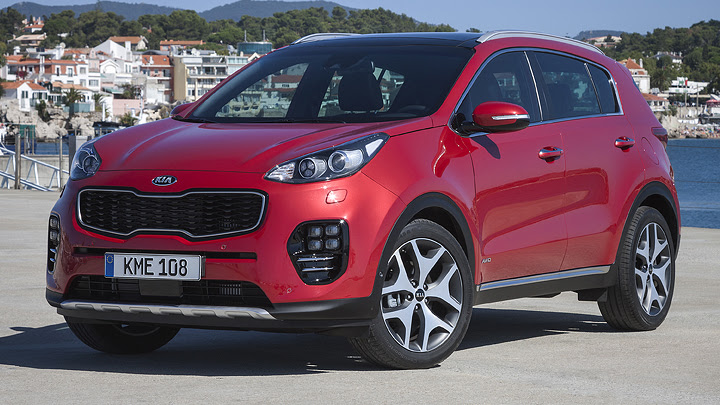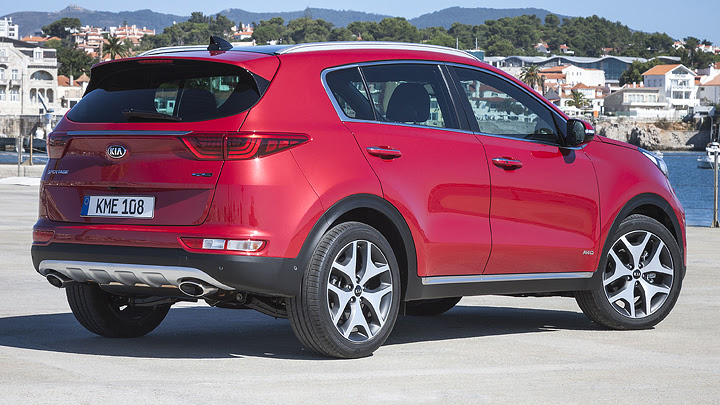
If you’re used to read about the automotive world, you certainly already know Sportage’s history: its first iteration arrived as a tiny SUV, which was dedicated to young drivers and as unpretentious as it was possible before the crossover era. The following was the first one concocted under Hyundai’s ownership of Kia, which implied spawning the first Tucson almost as a twin car. Things would only start taking that wonderful spin in the late 2000s: since the current phase of those two was born after the companies’ popularity boom (captained by Fluidic Sculpture and Tiger Nose), they finally became gorgeous examples of a very well-executed work with multiple brands. The result was another vicious circle, but this time positive enough to generate the Tucson and Sportage we’ll see on sale soon.
Having all that in mind, a great way to analyze Sportage’s new design is by comparing it with its brother (check some of its pictures here and here). Hyundai used sleek elements emphasizing their horizontal dimension, to convey the sense of bigger size. Kia, in turn, invested in rounded shapes without direct visual connections, which aids to a more playful interpretation of sportiness. Besides, Tucson relies on bigger windows and stronger creases to create a chiseled design, while its sibling extracts imponence out of smoother contours and larger portions of sheetmetal. As if it wasn’t enough, each automobile is a great follower of the very latest design tendencies established by their respective manufacturers: if you want some frame of reference, check out the current Sorento and Santa Fe, for instance.








As usual among Kias, the interior is much more discreet. The dominant color is black, there are few chrome inserts, and the overall shapes are quite simple – not bad-looking at all, though. On the other hand, there are better materials, the dashboard was inclined 10 degrees towards the driver, and the 7” or 8” touchscreen was placed between the central air vents without replacing all the physical buttons. But if you ask someone from Kia about this, they’ll be much happier to talk about the new dimensions: compared to the outgoing Sportage, headroom increased by 0.2 inch at the front and 0.6 inch at the rear, while legroom stretched by 0.75 and 0.3 inch, respectively. The cargo floor, in turn, was lowered by 1.6 inch without any change to the previous ground clearance.
Such increases came from both a new use of the existing room and making it slightly bigger. If you want more numbers, the wheelbase was stretched by 1.6 inch, while the front overhang grew by 0.8 inch and the rear one shrunk by 0.4 inch. Going to less critical changes, the C-pillars are 2.4 inches thinner, while the panoramic sunroof is 4.1 inches longer. The entirely new Sportage also features handling-oriented improvements, such as multilink independent layout for the rear suspension, 39% higher torsional rigidity, and some revisions to the electrically-assisted steering. As far as safety is concerned, there are new electronic programs (depending on the trim level): automatic emergency braking, automatic high beams, blind-spot monitoring, lane-departure warning, lane-keeping assist, and rear cross-traffic alert.




Sportage’s new engine range combines new and carried-over engines. The gasoline range starts with the 1.6-liter GDI unit, once again; it generates 132 hp of power and 16.4 kgfm of torque. If you want more power, the T-GDI is a variation of the previous one which was borrowed from the European cee’d GT. Besides the turbocharger, it uses a series of performance enhancements to deliver 177 hp and 27 kgfm. Switching to diesel, the 1.7-liter CRDi appears once again and generates 117 hp, but the star of this lineup is the 2.0: another batch of improvements took it to 136 hp and 38 kgfm, or to 184 hp and 40.8 kgfm. Regarding transmissions, the six-speed manual and automatic were joined by Kia’s brand new DCT, which uses two clutches and seven speeds and only comes with the T-GDI engine.
The last piece of news one can show about this crossover is the GT Line trim level, which Kia already offers for the entire cee’d lineup. Since Sportage is their direct counterpart (as Sorento, for instance, would be for Optima), and this category is known for having become increasingly urban, Kia’s staff must’ve thought “why not?”. The external tweaks include different fog lights, aluminum-effect skid plates, dual exhaust mufflers, fake air diffuser at the rear bumper, and exclusive design for the 19” wheels. The cabin adds a new leather steering wheel, aluminum alloy pedals, and the central stack painted in piano black. Once again as usual, the equipment list is complete, and the suspension gets its own tuning, which aids to a sportier dynamic behavior. This trim only uses the T-GDI engine and the DCT gearbox.